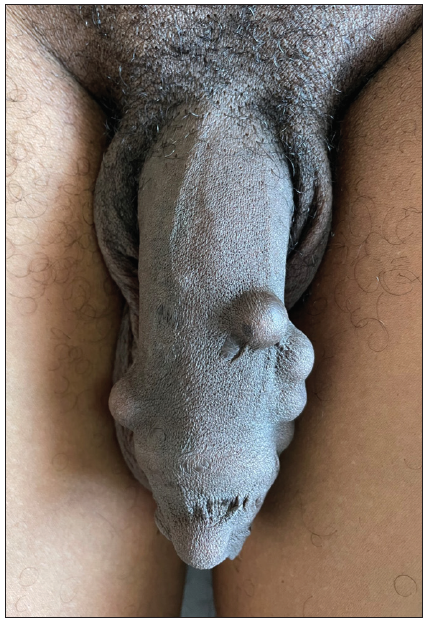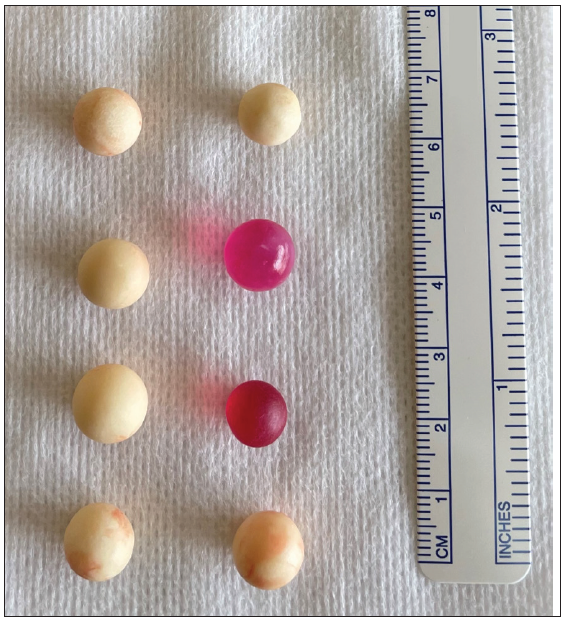Translate this page into:
Penile implants, a cultural practice in the carceral milieu of French West Indies region: A case report
Corresponding author: Dr. Nicolas Olivier, Department of Dermatology, University Hospital of Martinique, Fort de France, Martinique. erico83100@hotmail.fr
-
Received: ,
Accepted: ,
How to cite this article: Ratovonjanahary V, Valentin J, Amazan E, Olivier N. Penile implants, a cultural practice in the carceral milieu of French West Indies region: A case report. Indian J Dermatol Venereol Leprol. 2025;91:S63-S64. doi: 10.25259/IJDVL_784_2023
Dear Editor,
Penile implants are foreign bodies, usually polished in a nodular shape, voluntarily inserted under the skin of the penis. It is a common practice in the Caribbean prison environment.1 The purpose of this practice varies from sexual to socio-cultural context.2 We report a case of penile implant seen in the Dermatology department of the University Hospital of Martinique, French West Indies.
A 41-year-old gentleman visited the dermatology department seeking removal of beads from his penile area. During clinical examination, eight subcutaneous nodules were detected on the penis. These nodules appeared to be firm, non-inflamed, movable, and not adhering to the subcutaneous tissues. [Figure 1]. Patient had inserted these beads himself with the assistance of his prison cellmate 21 years ago. Before incarceration, the patient engaged in heterosexual activity and exhibited high risk behaviour, including having multiple partners. Serology for HIV, hepatitis B and C, and VDRL were performed prior to surgery and were negative. We surgically removed all of the beads, measuring 0.8–1 cm in diameter, by simple incision of the superficial skin layer and opening of the peripheral fibrous envelope, and then closing by simple suture. Six of the beads were made with ivory dominoes, and the last two with a plastic toothbrush. The post-operative follow-up was uneventful, with complete healing within 7 days after surgery.

- Subcutaneous nodules of the penis foreskin.

- Post-surgical penile beads called “love balls”.
This phenomenon of self- or hetero-implantation of penile subcutaneous beads is an ancient practice well-known in Southeast Asia.2 It is mentioned in the Kama Sutra and among the Yakuza as a rite of transition and of belonging to the clan.3 It then spread with immigration to Eastern Europe, Australia, and America and has multiple names depending on the region, such as “love balls in Martinique, but also “marbles”, “bouglous or “dominoes in other Caribbean regions.4 Today, this practice can be found in various parts of the world, with similar significance among different social groups such as prisoners, military units in Russia and Asia, low socio-cultural communities in South-East Asia, and criminal organisations in Japan.2 Other voluntary cultural sexual modifications are practiced in certain communities for hygienic reasons, for example, circumcision in Africa.5 Penile implant practice is well known in the prison environment of the French West Indies region. In 2019, a study conducted in French Guiana reported that 68% of prisoners had penile implants.6 The insertion of these objects is voluntary, motivated by false beliefs of increased virility, sexual performance, and sexual pleasuring of the partner but also by socio-cultural motivations of belonging to the group. Their round or oblong shape without asperities facilitates their introduction after a simple incision with a razor blade. This procedure is often performed under poor hygienic conditions and is associated with a high risk of infection and transmission of viral infections such as HIV, hepatitis B or C, and other sexually transmitted diseases in this population.6 Transformation into squamous cell carcinoma has also been documented, although it is typically linked with additional risk factors for genital carcinoma.7 In the West Indies, this cultural tradition, observed among a vulnerable population, necessitates physicians to provide essential counselling, conduct comprehensive clinical examinations, and screen for sexually transmitted infections when treating these patients.
Declaration of patient consent
The authors certify that they have obtained all appropriate patient consent.
Financial support and sponsorship
Nil.
Conflicts of interest
There are no conflicts of interest.
Use of artificial intelligence (AI)-assisted technology for manuscript preparation
The authors confirm that there was no use of artificial intelligence (AI)-assisted technology for assisting in the writing or editing of the manuscript and no images were manipulated using AI.
References
- Prevalence and predictors of penile nodules in French Guiana’s sole prison facility. PLoS One. 2018;13:e0204808.
- [CrossRef] [PubMed] [PubMed Central] [Google Scholar]
- Implantation of artificial penile nodules--a review of literature. J Sex Med. 2010;7:3565-71.
- [CrossRef] [PubMed] [Google Scholar]
- Artificial penile bodies-from kama sutra to modern times. J Sex Med. 2009;6:1543-8.
- [CrossRef] [PubMed] [Google Scholar]
- Artificial penile nodes (“bouglous”) in prisons in French Guiana. Ann Dermatol Venereol. 2015;142:S585.
- [Google Scholar]
- Circumcision and its effects in Africa. Transl Androl Urol. 2017;6:149-57.
- [CrossRef] [PubMed] [PubMed Central] [Google Scholar]
- Penile implants and other high risk practices in French Guiana’s correctional facility: A cause for concern. PLoS One. 2019;14:e0218992.
- [CrossRef] [PubMed] [PubMed Central] [Google Scholar]
- Penile cancer in patient with a “Bouglou” penile adornment. J Surg Case Rep. 2014;2014:rju126.
- [CrossRef] [PubMed] [PubMed Central] [Google Scholar]






